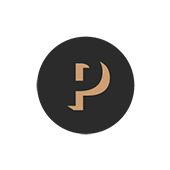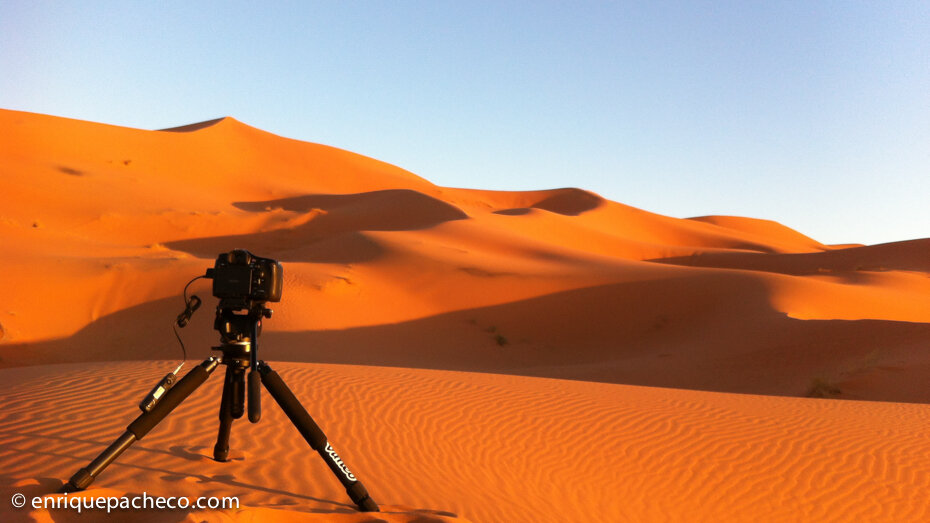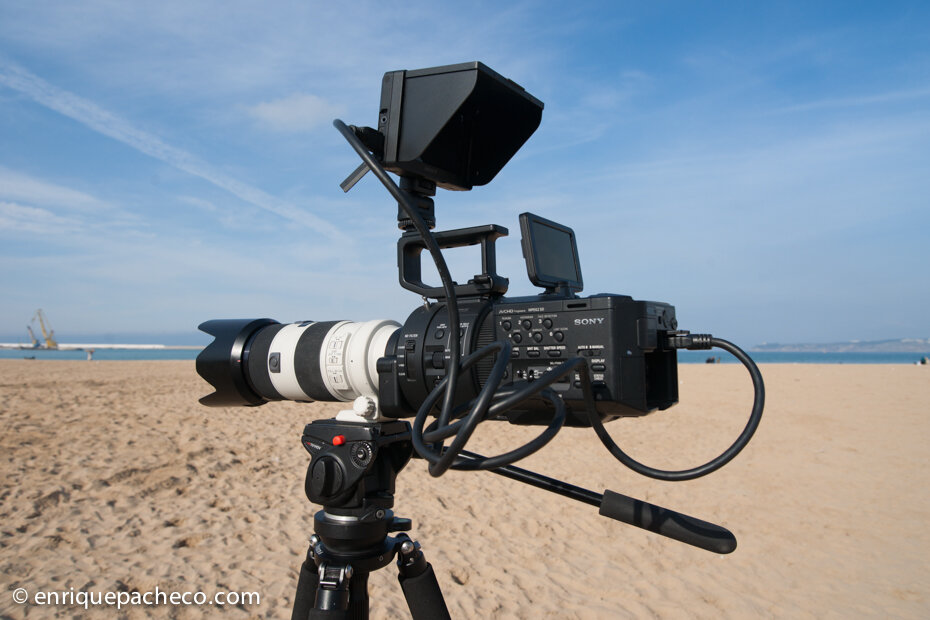Shooting “The Maghreb”
When I decided to go to Morocco to film “The Maghreb”, I knew I would need gear that could cover all situations that I’d find in a country with so many possibilities. I needed at least two good DSLR for the time-lapses, many of them at night, and a camcorder that allowed me to record at a high frame rate to get slow motion footage. I also needed a motorized slider, a stabilizer and of course a good set of lenses. In the next post I will describe what I chose and more importantly, why I chose this equipment and how I used it.
DSLR Cameras: SONY A99
When I heard that Sony was going to release a full frame DSLR I showed interest in this camera, knowing Sony was going to be innovative and include features that professionals like me are demanding as a must have. Shooting in places like Morocco, where dust and sand are a constant, it is essential to have a camera with a sealed body, this is no secret and most brands offer this feature in high end models, but having also a foldable screen in this kind of body is a bonus. For me, this feature is a must, since I love shooting with the camera at ground level and also put it on the slider in that position. If the screen is fixed you have to lay in the ground and get dirty or wet to be able to check the frame.
Another quality that is essential to me in a DSLR is low noise at high sensitivities, between 1600 and 3200 iso, because when shooting night time-lapses I have to keep the shutter speed under 30s, in order to get the stars sharp and to avoid trails. Here the Sony A99 Performs fantastically, offering a very clean image without color noise, although the noise luminance is evident from ISO 3200 is easily fixable in Ligthroom.
The electronic viewfinder or EVF and its partner the translucent mirror are not inconvenient for me- but quite the opposite. The EVF allowed me to frame in any kind of situation while showing me information like level, histogram, etc.. And the translucent mirror helps prevent camera shake in long exposures, since the camera has no moving parts that could transmit vibrations to the shot, apart from the shutter of course, but with the A99 you can eliminate the first click of the shutter, replacing it for an electronic one.
In short, the Sony A99 performed perfectly in all difficult situations that I encountered, I had no problem shooting in the most demanding locations, proving that it is a professional tool that you can trust to the highest technical level.
Camcorder: SONY FS700
Choosing the Sony FS700 as the camcorder for this film seemed obvious, first for its ability to record up to 240fps in FullHD, and second by having NEX mount, which allowed me to use all the great Zeiss lenses from the Alpha series, which I had already for the Sony A99. To be able to carry just one set of lenses for two different systems is a great advantage, not only to save space and weight in your backpack, essential when making a trip by yourself with no assistance, it also helps providing consistency and continuity to the look of the final image. Not forgetting of course the cost savings from not having to buy two twice the same focal lenghts. The lenses I chose where the zooms 16-35mm f2.8 and 70-200mm f2.8 and the primes 24mm f2 and 50mm f2.8 macro.
Before traveling to Morocco, I did several tests with the FS700 to determine the settings where the camera performs best, both in dynamic range and image compression. Regarding dynamic range, the chose of the color profile in the menu is what mainly determines how the camera will distribute the stops. First I tried the custom profile LOG type from Abelcine, but then I realized that while delivering an image with a wide dynamic range, very flat and low contrast, apparently ideal to grade, tended to lift the shadows way too much, producing excessive noise even at his nominal sensitivity, 500iso. After several tests I concluded that the profile that best suited my needs was the Cinema6 of the camera, which was still quite flat but has an optimal noise/contrast correlation. This is quite subjective of course, so I will say that this is just my opinion and suited the look I wanted for this particular film.
Regarding the frame rate, I used 50fps for most of the shots, since the quality is as good as 25ps, and 200fps for the scenes where slow motion was required. While this camera goes up to 800fps, it does it by lowing the resolution and compressing the image, resulting in footage with excessive aliasing and a decrease in sharpness. For this reasons I chose the 200fps, which are more than enough to get really fluid slow motion effects, and image quality barely shows artefacts regarding 25 or 50fps.
The FS700 has built neutral density filters, this was very handy and comfortable in a shoot like this, when in most cases I did not have time to open the bag and find the right filter, it would have been more difficult to use a matte box with square filters.
Another feature that seems to be out of the list of priorities of the professional is the autofocus, I am myself against the use of it in most of the cases, but in this work is been a real help. Both NEX and Alpha lenses with LA-EA2 adapter allow continuous autofocus on the FS700, which was most convenient in the shots where I used the Glidecam HD2000 stabilizer, because I didn`t have a focus puller and a wireless remote. The results speak for themself, totally sharp and focused shots without any failure, which would have been impossible otherwise, having had to focus at the hyperfocal which becomes complicated when working with wide apertures, in the case of the dark streets of the medinas of Fes and Marrakech.
In conclusion, the FS700 has filled my expectations in terms of resolution, look and quality, as well as its ease of use and performance, not to mention its high frame rate and the ability to use almost any lens on the market by a simple adapter ring, although in this case the Zeiss lenses were the perfect company.
Motorized Slider: Xlidercam-M
If the camera and the optics are important, so too are the accessories that help create dynamic images. The motorized sliders have become an indispensable tool in many professional productions. Having tried many of these sliders, the economic Dynamic Perception and the expensive Kessler, I can say without hesitation that the KietaCAM Xlidercam-M is the slider that counts with the best features and performance level, as well as being easier to use. I can set it up in minutes, getting smooth and fluid movements, and what is most important to me, thanks to its control by a Tablet and a specially developed application, I get accurate information about interval, shot duration, and clip length.
The Xlidercam-M has two powerful and accurate motors, providing both movement along the rail and horizontal pan. It may seem heavier and bigger than other sliders, but not so much considering that it has both movements. I have traveled with it to places like the USA, Iceland and Morocco and have never seen a problem in its size or weight. Its robustness and reliability make it a the most professional tool. I don`t want to travel to a place like Morocco and miss the perfect shot because the slider lets you down in the middle of the dunes. The costs of such a trip and the time is worth much more than the money you can save on more economic and less reliable tools.
I hope this article helps you to understand a bit more how professionals work and why we choose the equipment according to the needs of each project.
If you liked this, you might like to follow my Facebook page here. Also, check out an article by my friends from Overland Site about their trip to Morocco, here.






